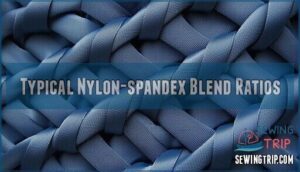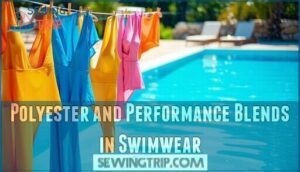This site is supported by our readers. We may earn a commission, at no cost to you, if you purchase through links.
 You’ll find that most bathing suits use nylon-spandex blends, commonly 80% nylon and 20% spandex. This combination gives you the stretch and comfort you need while maintaining shape through countless swims.
You’ll find that most bathing suits use nylon-spandex blends, commonly 80% nylon and 20% spandex. This combination gives you the stretch and comfort you need while maintaining shape through countless swims.
Polyester blends have gained traction for good reason – they laugh off chlorine damage and block harmful UV rays.
Think about what your swimsuit goes through: harsh pool chemicals, salty ocean water, blazing sun, and endless stretching as you move.
Quick-drying fabric becomes essential when you’re cycling between pool and poolside.
Eco-friendly options like ECONYL regenerated nylon, made from recycled fishing nets, are becoming mainstream as brands respond to environmental concerns. Understanding these material choices helps explain why some suits last seasons while others lose their snap after a few beach trips.
Table Of Contents
Key Takeaways
- You’ll find nylon-spandex blends (80% nylon, 20% spandex) in most swimsuits because they deliver the perfect balance of stretch, comfort, and shape retention for everyday swimming and beach activities.
- Choose polyester blends if you’re a frequent pool swimmer since they resist chlorine damage and UV rays better than nylon, maintaining their color and elasticity through 300+ hours of pool time.
- Eco-friendly options like ECONYL recycled nylon perform just as well as traditional fabrics while reducing environmental impact by turning ocean waste like fishing nets into high-quality swimwear material.
- Proper care extends your suit’s life significantly – rinse after each use, hand wash with mild soap, air dry in shade, and avoid folding to prevent elastic fiber damage and maintain fabric integrity.
What Fabric is Used for Bathing Suits?
Modern swimsuits rely on carefully chosen synthetic fabric blends that can withstand water, chlorine, and repeated stretching.
The most popular combinations pair nylon or polyester with spandex, creating materials that hold their shape while giving you the flexibility needed for swimming and lounging poolside.
Key Swimsuit Fabric Types and Blends
Today’s swimwear relies on a smart combination of materials that work together seamlessly. Nylon brings that soft, comfortable feel against your skin, while spandex handles the heavy lifting when it comes to stretch and keeping everything in place. Polyester rounds out the trio with serious staying power—it won’t break down from pool chemicals or fade after countless beach days.
What makes this all possible is elastane, the flexibility factor that runs through every quality swimsuit fabric. As manufacturers keep pushing boundaries, we’re seeing more targeted fabric solutions designed for specific activities, whether you’re doing laps or lounging poolside.
Properties Required for Swimwear Materials
When you’re shopping for swimwear, the fabric makes all the difference in how your suit performs. You need material tough enough to handle whatever you throw at it – whether that’s ocean salt or pool chemicals trying to break it down over time.
The best swimwear fabrics won’t turn into a soggy mess the moment they hit water. Instead, they stay relatively light and move with your body, so you’re not fighting against heavy, waterlogged material. Your skin stays protected from UV rays while feeling comfortable against soft, non-irritating textures.
A quality suit holds its shape season after season, keeping that perfect fit you loved when you first tried it on. The fabric stretches when you need it to – for that diving reach or volleyball spike – then snaps back into place. Even after countless pool sessions, chlorine-resistant materials maintain their integrity and color.
Nylon and Spandex: The Classic Swimwear Blend
You’ll find the 80% nylon and 20% spandex combination in most swimsuits because this blend delivers the perfect balance of stretch and structure.
This classic fabric pairing gives you comfortable movement in the water while maintaining your suit’s shape through countless swims and sun sessions.
Typical Nylon-spandex Blend Ratios
Most swimsuit fabric combines 80% nylon with 20% spandex, creating the perfect balance for swimwear. Nylon blends provide durability, while spandex blends deliver flexibility.
This blend ratio impact guarantees best stretch recovery rate while maintaining shape. The weave and ratio affect comfort vs. firmness dynamics.
Cost considerations favor this standard formula. Stretchable fabrics with this composition dominate swimwear fabric choices for good reason.
Comfort, Stretch, and Fit Advantages
Why does nylon-spandex feel like a second skin? This swimsuit material creates body-conforming comfort through enhanced comfort and shape retention.
Spandex blends provide freedom of movement while maintaining a fabric feel that moves with you. The swimwear fabric characteristics deliver stretch that returns to its original form, making sure your swimsuit material maintains its fit through countless swims and beach days.
Limitations and Care Considerations
While nylon-spandex blends offer excellent comfort, they’re not without drawbacks. Chlorine damage breaks down elastane fibers, causing elasticity loss and saggy fits over time. Sun exposure fades colors and weakens swimsuit material.
You’ll need proper storage away from heat and humidity. Rinse immediately after swimming to prevent stain buildup.
Though chlorine-resistant fabrics exist, traditional nylon blends lack strong UV protection, requiring careful maintenance to preserve swimwear fabric properties and extend lifespan.
Polyester and Performance Blends in Swimwear
When you’re shopping for swimwear that can handle serious pool time, you’ll want to think about polyester blends over traditional nylon options.
Polyester-spandex combinations offer greater chlorine resistance and UV protection, making them the best choice for competitive swimmers and frequent pool users who need their suits to maintain shape and color.
Polyester-spandex Combinations for Durability
Polyester blends with spandex create swimsuit fabric that’s built like a tank. These durable fabrics commonly use 80-85% polyester with 15-20% spandex for best spandex elasticity.
The polyester durability shines in competitive swimwear, where blend ratios matter most. Unlike nylon, polyester maintains print longevity and color vibrancy longer.
These spandex blends resist pilling and stretching out of shape.
Chlorine and UV Resistance in Competitive Suits
Pool chlorine is tough on swimsuits. It breaks down regular fabrics fast, which is why competitive swimmers need suits built differently.
Thanks to better fabric treatments and chlorine-resistant materials, today’s performance suits can handle the pool chemistry much longer than older designs.
- PBT/polyester blends maintain strength for 300+ hours in chlorinated water
- UV protection reaches UPF 50+ ratings, blocking 98% of harmful rays
- Chlorine degradation reduces breaking force by only 12.4% after 200 hours
Polyester fibers are chosen for their abrasion resistance. Durable fabrics with specialized treatments make your competitive advantage last season after season.
Print Quality and Color Retention
Vibrant colors stay true longer when you choose quality swimsuit material with excellent dye absorption. Polyester blends excel at colorfastness testing, resisting sunlight fading and saltwater effects better than other options.
This swimwear fabric characteristics make them ideal for frequent swimmers. Print vibrancy remains consistent through chlorine resistance and UV resistance properties, making sure your suit looks fresh season after season.
Eco-Friendly and Sustainable Swimwear Fabrics
You’re witnessing a major shift in swimwear manufacturing as brands adopt recycled materials like ECONYL regenerated nylon, made from fishing nets and plastic waste, and REPREVE fibers created from recycled bottles.
These resourceful fabrics deliver the same stretch, durability, and chlorine resistance as traditional materials while reducing environmental impact by up to 80%.
ECONYL and REPREVE Explained
Two ground-breaking fabrics are transforming sustainable swimwear through resourceful recycling. ECONYL recycled nylon emerges from discarded fishing nets and industrial plastic waste, creating durable swimsuit fabric through a four-step ECONYL process. REPREVE benefits include converting plastic bottles into performance fibers, supporting waste reduction while maintaining swimwear quality.
- Your next swimsuit could rescue ocean debris from becoming permanent pollution
- These recycled materials perform identically to virgin fabrics without compromising stretch or durability
- Supporting sustainable sourcing helps close the fabric lifecycle loop for future generations
Environmental Impact and Consumer Trends
The sustainable swimwear market has exploded in recent years, jumping from $7.8 billion to an expected $16.2 billion by 2032.
Nearly half of all swimwear shoppers now look for recycled materials and ethical manufacturing before making a purchase.
However, greenwashing concerns remain as brands rush to meet sustainability expectations without genuine environmental commitments. This growth is largely attributed to increasing environmental awareness.
Zero-waste and Digital Pattern-making Techniques
Sophisticated digital swimwear design shifts how you think about waste reduction methods. Modern manufacturers use computer-aided cutting fabric waste systems that improve every inch of material, reducing scraps by up to 30% in sustainable pattern creation.
- Digital pattern-making eliminates paper templates, reducing material waste in swimsuit design
- Laser cutting technology makes the most of fabric utilization for eco-friendly swimwear production
- 3D modeling software improves swimwear materials before physical production begins
- Zero-waste techniques integrate multiple swimsuit fabric properties into single pattern layouts
Swimwear Fabric Care and Market Insights
You’ll extend your swimsuit’s life considerably by following proper care techniques, which becomes even more important when you consider the global swimwear fabric market’s $3.5 billion value and rapid growth.
Understanding market trends helps you make smarter fabric choices, as polyester and nylon dominate over 80% of production due to their proven durability and performance characteristics.
Proper Washing and Drying for Longevity
Taking care of your swimwear starts with proper washing frequency and detergent choice. Hand washing protects delicate swimsuit fabric properties better than machines. Use cold water and mild soap to preserve chlorine-resistant fabrics. Air dry away from direct sunlight to maintain elasticity and color.
| Care Step | Method | Why It Matters |
|---|---|---|
| Washing Frequency | After each use | Removes chlorine and salt |
| Detergent Choice | Mild, fragrance-free | Protects fabric fibers |
| Drying Methods | Air dry, shade | Prevents UV damage |
Storage solutions matter too. Store suits flat or rolled, never folded, to prevent creasing in elastic fibers.
Market Trends and Fabric Dominance
The swimwear fabric market is experiencing strong growth. The global swimwear fabric market size was valued at approximately USD 3.5 billion in 2023 and is expected to reach USD 5.2 billion by 2032.
When you’re buying swimwear fabric online or checking fabric specifications, you’ll notice these market trends shaping your swimwear line choices:
- Nylon emerged as the largest sub-segment, accounting for 40% of the market share
- Consumer demand drives sustainable growth in eco-friendly swimwear materials
- Regional analysis shows Asia-Pacific leading in fabric innovations
- Textured swimwear fabrics gain popularity for premium swimwear lines
- Market share battles intensify between traditional and sustainable material producers
Innovations and Future Fabric Developments
Beyond traditional blends, you’ll see exciting developments reshaping swimwear materials. Smart textiles monitor UV exposure, while biodegradable swimwear breaks down safely after use. Algae-based fabrics and game-changing materials promise performance enhancements.
| Innovation Category | Material Example | Key Benefit |
|---|---|---|
| Smart Textiles | UV-sensing fibers | Real-time sun protection alerts |
| Biodegradable Options | Seaweed-based polymers | Zero ocean pollution |
| Self-Healing Materials | Shape-memory alloys | Extended fabric lifespan |
| Algae-Based Fabrics | Bio-engineered fibers | Carbon-negative production |
| Performance Enhancements | Graphene integration | Excellent heat regulation |
These fabric specifications represent sustainability in swimwear’s future, transforming how we think about textile performance.
Frequently Asked Questions (FAQs)
Where can I find swimwear fabrics made from recycled materials?
You’ll find eco-friendly swimwear fabrics at ECONYL’s official e-shop, specialty fabric retailers like Vivify Textiles, or manufacturers like Swimwear Manufacturers that offer premium ECONYL with impressive sand resistance properties.
What are the benefits of using polyester blends in swimwear?
You’ll love polyester blends for their chlorine resistance and UV protection. They maintain vibrant colors, dry quickly, and offer excellent durability for competitive swimming and frequent pool use.
Are there any disadvantages to using nylon blends in swimwear?
Nylon blends can lose their stretch after chlorine exposure, making your suit baggy. They’re also prone to snagging on rough surfaces and may feel less comfortable against sensitive skin.
How do I choose the right fabric weight for my bathing suit?
Choose lighter weights (200-250 GSM) for comfort swimming and heavier weights (280-320 GSM) for competitive use.
You’ll want medium stretch for recreational suits, high stretch for performance.
Consider your activity level and body type when selecting fabric density.
Can I use cotton or wool fabrics to make a swimsuit?
You shouldn’t use cotton or wool for swimsuits. These natural fibers absorb water heavily, lose shape when wet, and take forever to dry. They’ll feel uncomfortable and saggy underwater.
What swimsuit fabrics work best for saltwater?
When ocean adventures beckon, polyester blends are ideal for saltwater swimming. You’ll find polyester maintains vibrant colors against UV rays while resisting salt corrosion better than nylon alternatives.
How do fabric blends affect swimsuit pricing?
Premium fabric blends like nylon-elastane cost more than basic polyester options.
You’ll pay extra for chlorine-resistant polyester or sustainable ECONYL materials.
Higher spandex percentages increase prices due to enhanced stretch and recovery properties.
Which materials cause skin irritation or allergies?
Synthetic materials like polyester, nylon, and spandex can trigger reactions in sensitive skin. These fabrics don’t breathe well, causing excessive sweating and irritation.
Chemical treatments and dyes often cause the worst reactions, not the fibers themselves.
What fabrics provide the most sun protection?
You’ll want polyester-based blends for serious sun defense. UPF 50+ fabrics block 98% of harmful UV rays, while regular swimsuits only provide UPF 5 protection. Dark colors outperform lighter shades in blocking radiation.
How long do different swimwear fabrics last?
You’ll get different lifespans depending on fabric type. Polyester blends last longest, generally 2-3 years with proper care.
Nylon-spandex suits wear out faster, lasting 1-2 years. Chlorine destroys spandex quickly, reducing lifespan considerably.
Conclusion
Imagine this: your favorite swimsuit from three summers ago now fits like a deflated balloon. Knowing what fabric is used for bathing suits helps you make smarter purchases.
Understanding swimsuit fabrics prevents that heartbreaking moment when your favorite suit turns into a saggy disappointment
Nylon-spandex blends dominate the market because they balance stretch, comfort, and durability perfectly. Better polyester options offer chlorine resistance for pool enthusiasts, while eco-friendly materials like ECONYL provide guilt-free swimming.
Choose fabrics based on your swimming habits—casual beachgoers can stick with classic nylon blends, while competitive swimmers benefit from performance polyester. Your swimsuit’s longevity depends entirely on fabric choice.
- https://swimzip.com/pages/guide-to-swimwear-fabrics
- https://maake.com/blogs/fabric/swimwear-fabric-choices
- https://fashionsfl.com/blogs/news/swimwear-fabric-guide
- https://www.swimoutlet.com/blogs/guides/understanding-competition-swimsuit-fabrics
- https://www.cheekychickadeestore.com/pages/best-swimsuit-materials














